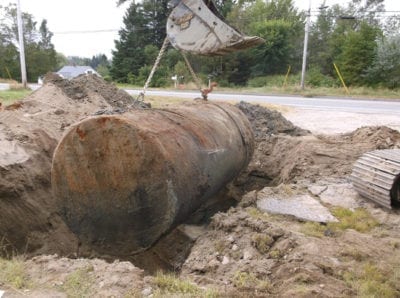Your Reliable Partner for Underground Storage Tank Detection and Removal
What is an Underground Storage Tank (UST)?

Locating underground storage tanks or UST is a common use for ground penetrating radar. Finding USTs or buried drums can be accomplished with a low-frequency antenna. Whether the tank was installed decades ago or is buried under concrete, driveways, roads, or asphalt parking lots, our professional GPR team can detect it!
Many underground storage tanks were designed for fuel storage, back when oil was used to heat Texas homes and commercial buildings. Old gas stations can have multiple, large underground storage tanks that are critical to discover before any construction begins.
USTs can also hold septic waste, propane, and fast food grease. Most USTs are built with metal (steel, cast iron, and even copper), although fast food traps can be constructed with plastics and concrete.
How Underground Storage Tank Locating Works
The initial step in locating an underground tank involves scrutinizing available records and performing a meticulous visual inspection. This helps to identify potential UST locations. Afterward, advanced devices, including ground-penetrating radar (GPR), magnetometry, or electromagnetic conductivity (EM), map the subsurface.
A ground penetrating radar, especially effective for oil tank detection, transmits high-frequency radio signals into the ground. These signals rebound to the receiver when they encounter solid objects like USTs. The resulting data aids in establishing the precise location and dimensions of the tank, enabling efficient underground tank inspection and eventual storage tank removal.
On the other hand, magnetometry and EM record changes in the earth’s magnetic field or conductivity, which the presence of a metal UST can alter. These sophisticated techniques provide added assurance in the UST detection process, making it a precise and reliable science.
The Need for Underground Storage Tank Locating
The necessity for underground storage tank locating extends beyond property management—it has environmental, financial, and legal implications. Neglected or undiscovered USTs can trigger serious issues, including environmental threats and significant monetary losses.
When a UST leaks, it can pollute the surrounding soil and groundwater, creating an environmental disaster and potential health risks. Should this occur on your premises, you’re accountable for the exorbitant cleanup costs. Even worse, the presence of an unknown UST can devalue your property, posing financial risks and daunting cleanup responsibilities to potential buyers or developers.
Regulations governing UST management are stringent to protect public health and the environment. Breaches can lead to legal consequences. Thus, locating USTs is a proactive step toward environmental conservation, financial security, and legal compliance.
Choosing the Right Locating Service
Choosing a professional service for underground storage tank locating is a decision that requires thorough research and consideration. Remember, locating a UST involves more than detection—it’s about accuracy, efficiency, and safety.
Begin by evaluating the provider’s experience and track record. How many years have they been offering these services? Do their past clients vouch for their reliability? Companies with longevity and positive client testimonials are likely to deliver dependable service.
By investing time and effort in selecting the right service like Wood Inspection Services, you are investing in your property’s safety, environmental preservation, and overall peace of mind.
Recent UST Projects Completed by Wood
View full screen map
Discovery of Underground Storage and Oil Tanks Without GPR
Many general contractors and inspectors may hesitate to deploy GPR technology and opt for metal detection or line/pipe/vent tracing. Storage tanks that are active are easy to locate without GPR and are often in close proximity to a building.
While a high-end metal detector can locate subsurface obstructions such as USTs, it cannot determine approximate tank size or depth. Underground storage tanks buried below concrete/asphalt are not a problem for GPR, which can even reveal thickness and whether there are rebar reinforcements.
Another benefit of GPR is locating abandoned storage tanks or tanks that have been excavated and removed. Voids and air space underground can be scanned and mapped by a qualified team, preventing a sinkhole.
Wood Inspection is sometimes hired after a professional metal detection survey has already been completed. There are many limitations to metal detection from depth to material and accuracy. Avoid paying twice for a subsurface inspection. Get a single-inclusive report and hire a professional GPR contractor.
Before You Start Digging
Underground storage tanks when filled with fuel are a huge potential liability. Our team was hired after excavation began and construction equipment was damaged. Avoid destroying a tank, causing an explosion and injury to workers, and delaying the project.
Often, underground storage tanks need to be discovered for real estate disclosures or before a new project can break ground.
GPR maps the entire exterior of tanks and can reveal if a UST is punctured or if pipe and vent connections are severed. A soil test provides the best analysis of leaks for environmental cleanup, while GPR can reveal the next steps for tank replacement or repair.
Underground Fuel Tank Inspection
Wood Inspection performs commercial subsurface scanning for building owners, general contractors, engineering firms, real estate appraisers, homeowners, investors land owners, and even other commercial building inspectors.
Our mapping process and equipment are comprehensive and include metal detection, magnetometers, ground penetrating radar, and Radio Frequency. Uncover specifics on your underground storage tank so you can plan on removal, excavation, or getting a tank back to active use.
Get a free quote and timeline estimate from our team on your underground storage solution!

 Contact Us
Contact Us Call Us
Call Us